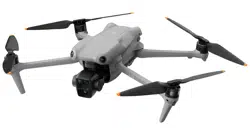Loading ...
Loading ...
Loading ...

DJI Air 3
User Manual
©
2023 DJI All Rights Reserved.
69
• A gimbal motor may enter protection mode if the gimbal is obstructed by other objects
when the aircraft is put on uneven ground or on grass, or if the gimbal experiences an
excessive external force, such as during a collision.
• DO NOT apply external force to the gimbal after the aircraft is powered on.
• DO NOT add any extra payload other than an ocial accessory to the gimbal, as this
may cause the gimbal to function abnormally or lead to permanent motor damage.
• Remove the gimbal protector before powering on the aircraft. Attach the gimbal
protector when the aircraft is not in use.
• Flying in heavy fog or clouds may make the gimbal wet, leading to temporary failure.
The gimbal will recover full functionality once it is dry.
Camera Prole
DJI Air 3 features a dual-camera system which consists of a wide-angle camera and a medium
tele camera, suitable for dierent shooting scenarios.
The wide-angle camera boasts a 1/1.3-in CMOS sensor with 48MP effective pixels. With an
aperture of f/1.7 and an equivalent focal length of 24 mm, the wide-angle camera can shoot
from 1 m to innity. It can take 4K 60fps videos and 48MP photos, and supports up to 3x zoom.
The medium tele camera boasts a 1/1.3-in CMOS sensor with 48MP eective pixels. With an
aperture of f/2.8 and an equivalent focal length of 70 mm, the medium tele camera can shoot
from 3 m to innity. It can take 4K 60fps videos and 48MP photos, and supports up to 9x zoom.
• Make sure the temperature and humidity are suitable for the camera during use and
storage.
• Use a lens cleanser to clean the lens to avoid damage or poor image quality.
• DO NOT block any ventilation holes on the camera as the heat generated may damage
the device and injure the user.
• The cameras may not focus correctly in the following situations:
a. Shooting dark objects far away.
b. Shooting objects with repeating identical patterns and textures or objects without
clear patterns or textures.
c. Shooting shiny or reective objects (such as street lighting and glass).
d. Shooting ashing objects.
e. Shooting fast-moving objects.
f. When the aircraft/gimbal is moving fast.
g. Shooting objects with varying distances in the focus range.
Loading ...
Loading ...
Loading ...
